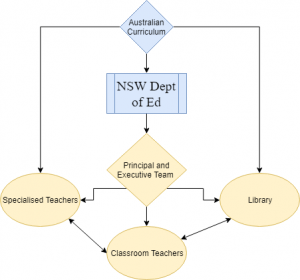Significant Issues
- Overwork
- Physical and mental health
- Home/family life balance
- Performance review
Future strategies
The initial year in a new position in a new workplace will always be challenging. Routines, culture and organisational processes differ between schools and time is needed to familiarise yourself with these factors so they become routine. This alone will take time to internalise, let alone meeting and working with a new group of people and establishing relationships. The TL in case study 6 has not only all of the above factors to contend with in a new position but has also led many changes in the school library including: staff roles/satisfaction in the workplace, writing a budget, led staff PD, revised vision/mission statements, promoted the library, provided evidence based practice related to outcomes, worked closely with teachers and improve the communication systems within the school to name a few. A significant list. It is now time for the TL to reflect on her year with the Annual review. However, when all the achievements of the year are listed together, there are many successes to be proud of. Jealousy amongst heads of department are only due to budget allocation and relationship with the principal, not your work performance and the significant value adding the library has enjoyed this year to the school. A shift in leadership style to include servant leadership to guide and allow library staff to step up and be more involved in general operations and organisation will more evenly distribute workload. Other TLs across the campus and library support staff can be empowered to run programs to gain experience and confidence.
The TL needs to reassess her time commitment and reorganise her work within time limits and to hydrate (Craddock, 2019). She can concentrate on maintaining new initiatives already established and begin to distribute leadership and reallocate some of these tasks to library staff. On the home front our TL could write a list of stresses and divide the list into those she can control and those she cannot. Writing possible solutions for the list where you can control the outcomes (Welham, 2013). A short list of goals for the coming year will assist with family and health issues.
Realigning the following year’s Personal Development Plan (PDP) to include these strategies will increase job satisfaction and personal wellbeing.
Craddock, I. (2019). Self-care tips for school librarians. Retrieved from: https://www.slj.com/?detailStory=Self-Care-for-School-Librarians
Welham, H. (2013, November 6). 10 ideas to help teachers beat stress. The Guardian. Retrieved from https://www.theguardian.com/teacher-network/teacher-blog/2013/nov/06/teachers-beat-stress-10-ideas



 Draft 2.
Draft 2. 

